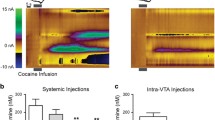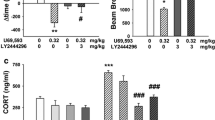Abstract
Rats were treated chronically with either cocaine (20 mg/kg/day, 14 days), morphine (incrementing doses of 10 mg/kg/day to 80 mg/kg, 11 days) or saline. During morphine or cocaine abstinence (48 h), dependent rats showed increased anxiety-like behavior in a conditioned defensive burying paradigm as evidenced by significantly shorter latencies to begin burying as well as a 4-fold increase in burying duration relative to salinetreated animals. This withdrawal-induced increase in burying behavior was blocked by pretreatment with either the β-adrenergic antagonist propranolol (5 mg/kg) or the lipophobic selective β1-antagonist, atenolol (5 mg/kg). These results are consistent with the possibility that activation of peripheral β1 receptors may substantially contribute to withdrawal-induced anxiety and that β-adrenergic antagonists could be useful in treating in cocaine and morphine dependent addicts.
Similar content being viewed by others
References
Abrahamsson T, Ek B, Nerme V (1988) The beta 1- and beta 2-adrenoceptor affinity of atenolol and metoprolol. A receptorbinding study performed with different radioligands in tissues from the rat, guinea pig and man. Biochem Pharmacol 37:203–208
Aghajanian GK (1978) Tolerance of locus coeruleus neurons to morphine and suppression of withdrawal response by clonidine. Nature 276:186–188
Agon P, Goethals P, Van Haver D, Kaufman JM (1991) Permeability of the blood-brain barrier for atenolol studied by positron emission tomography. J Pharm Pharmacol 43:587–600
Akaoka H, Aston-Jones G (1991) Opiate withdrawal-induced hyperactivity of locus coeruleus neurons is substantially mediated by augmented excitatory amino acid input. J Neurosci 11:3830–3839
Auriacombe M, Tignol J, Le Moal M, Stinus L (1990) Transcutaneous electrical stimulation with limoge current potentiates morphine analgesia and attenuates opiate abstinence syndrome. Biol Psychiatry 28:650–656
Baldwin HA, Rassnick S, Rivier J, Koob GF, Britton KT (1991) CRF antagonist reverses the “anxiogenic” response to ethanol withdrawal in the rat. Psychopharmacology 103:227–232
Carlsson C (1976) Propranolol in the treatment of alcoholism: a review. Postgrad Med J 52 [suppl 4]: 166–167
Charney DS, Sternberg DE, Kleber HD, Heninger GR, Redmond DE Jr (1981) The clinical use of clonidine in abrupt withdrawal from methadone. Arch Gen Psychiatry 38:1273–1277
Childress AR, McLellan AT, Natale M, O'Brien CP (1987) Mood states can elicit conditioned withdrawal and craving in opiate abuse patients. NIDA Res Monogr 76:137–144
Cole BJ, Koob GF (1988) Propranolol antagonizes the enhanced conditioned fear produced by corticotropin releasing factor. J Pharmacol Exp Ther 247:902–910
Costall B, Kelly ME, Onaivi ES, Naylor RJ (1990) The effect of ketotifen in rodent models of anxiety and on the behavioral consequences of withdrawing from treatment with drugs of abuse. Naunyn-Schmiedeberg's Arch Pharmacol 341:547–551
Davis SF, Dickson VA, Moore SA (1982) Conditioning and retention of defensive burying as a function of the injection of a central cholinergic stimulant. J Gen Psychol 107:249–254
Emmett-Oglesby MW, Harris CM, Lane J, Lal H (1984) Withdrawal from morphine generalizes to a pentylenetetrazole stimulus. Neuropeptides 5:37–40
Emmett-Oglesby MW, Mathis DA, Moon RTY, Lal H (1990) Animal models of drug withdrawal symptoms. Psychopharmacology 101:292–309
File SE, Zharkovsky A, Gulati K (1991) Effects of baclofen and nitrendipine on ethanol withdrawal responses in the rat. Neuropharmacology 30:183–190
Fontana DJ, Commissaris RL (1989) Effects of cocaine on conflict behavior in the rat. Life Sci 45:819–827
Gallagher M, Kapp BS, Frysinger RC, Rapp PR (1980) β-adrenergic manipulation in amygdala central nucleus alters rabbit heart rate conditioning. Pharmacol Biochem Behav 12:419–426
Gawin FH, Kleber HD (1986) Abstinence symptomatology and psychiatric diagnosis in cocaine abusers: clinical observations. Arch Gen Psychiatry 43:107–113
Gilman AG, Goodman LS, Rall TW, Murad F (eds) (1985) The pharmacological basis of therapeutics, 7th edn. Macmillan, New York, pp 192–202
Grosz HJ (1972) Narcotic withdrawal symptoms in heroin users treated with propranolol. Lancet 2:564–566
Hall SM (1979) The abstinence phobia. NIDA Res Monogr 25:55–67
Harris GC, Aston-Jones G (1992) β-Adrenergic antagonists block withdrawal signs in morphine and cocaine dependent animals. Soc Neurosci Abstr 18:374
Harris GC, Williams JT (1992) Sensitization of locus ceruleus neurons during withdrawal from chronic stimulants and antidepressants. J Pharmacol Exp Ther 261:476–483
Hollister LE, Prusmack JJ (1974) Propranolol in withdrawal from opiates. Arch Gen Psychiatry 31:695–698
Lal H, Prather PL, Rezazadeh M (1991) Anxiogenic behavior in rats during acute and protracted ethanol withdrawal: reversal by buspirone. Alcohol 8:467–471
Louie AK, Lannon RA, Ketter TA (1989) Treatment of cocaine-induced panic disorder. Am J Psychiatry 146:40–44
Middlemiss DN, Blakeborough L, Leather SR (1977) Direct evidence for an interaction of β-adrenergic blockers with the 5-HT receptor. Nature 267:289–290
Pinel JPJ, Treit D (1978) Burying as a defensive response in rats. J Comp Physiol Psychol 92:708–712
Prather PL, Lal H (1992) Protracted withdrawal: sensitization of the anxiogenic response to cocaine in rats concurrently treated with ethanol. Neuropsychopharmacology 6:23–29
Prather PL, Rezazadeh MS, Lal H (1991) Mianserin in the treatment of ethanol withdrawal in the rat: prevention of behaviors indicative of anxiety. Psychopharmacol Bull 27:285–289
Redmond DE (1979) New and old evidence for the involvement of a brain noradrenergic system in anxiety. In: Fann WE, Karacan I, Porkorny AD, Williams RL (eds) Phenomenology and treatment of anxiety. Spectrum, New York, pp 153–201
Resnick RB, Kestenbaum RS, Schwartz LK, Smith A (1976) Evaluation of propranolol in opiate dependence. Arch Gen Psychiatry 33:993–997
Roehrich H, Gold MS (1987) Propranolol as adjunct to clonidine in opiate detoxification. Am J Psychiatry 144:1099–1100
Staneva-Stoytcheva D, Astrug A, Ivanov D (1989) Effects of some beta-adrenergic blockers on avoidance learning in rats. Methods Find Exp Clin Pharmacol 11:535–540
Treit D (1985) Animal models for the study of anti-anxiety agents: a review. Neurosci Biobehav Rev 9:203–222
Treit D, Pinel JPJ, Terlecki LJ (1980) Shock intensity and conditioned defensive burying in rats. Bull Psychon Soc 16:5–7
Treit D, Pinel JPJ, Fibiger HC (1981) Conditioned defensive burying: a new paradigm for the study of anxiolytic agents. Pharmacol Biochem Behav 15:619–626
Tyrer PJ, Lader MH (1974) Response to propranolol and diazepam in somatic and psychic anxiety. BMJ 2:14–16
Whiteside DA, Devenport LD (1985) Naloxone preshock and defensive burying. Behav Neurosci 99:436–440
Wikler A (1980) Opioid dependence: mechanisms and treatment. Plenum Press, New York
Wood DM, Lal H (1987) Anxiogenic properties of cocaine withdrawal. Life Sci 41:733–739
Yang XM, Gorman AL, Dunn AJ (1990) The involvement of central NE systems and corticotropin releasing factor in defensive-withdrawal behavior in rats. J Pharmacol Exp Ther 225:1064–1070
Author information
Authors and Affiliations
Rights and permissions
About this article
Cite this article
Harris, G.C., Aston-Jones, G. β-adrenergic antagonists attenuate withdrawal anxiety in cocaine-and morphine-dependent rats. Psychopharmacology 113, 131–136 (1993). https://doi.org/10.1007/BF02244345
Received:
Revised:
Issue Date:
DOI: https://doi.org/10.1007/BF02244345




